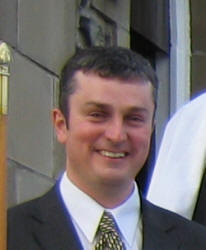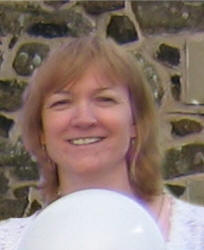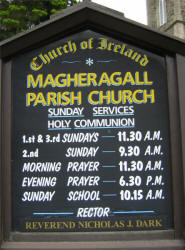
Magheragall Parish Church
|
|
|
|
Rev. Nicholas Dark
Rector |
Magheragall Parish Church. |
 |
 |
|
Nigel Adams
Rector's Warden |
Jacqui Adams People's Warden |
Ballinderry Road, Lisburn.
Rector: Rev. Nicholas Dark
Telephone: 9262 1273
Sunday Worship:
1st Sunday: 10.15am Sunday’s Cool
11.30am Morning Prayer
6.30pm Holy Communion
2nd Sunday: 11.30am Holy Communion
6.30pm Evening Service
3rd Sunday: 9.30am Holy Communion
11.30am Family Service
6.30pm Evening Prayer
4th Sunday: 11.30 Holy Communion
6.30pm Evening Prayer with Prayers for Healing
Website: www.magheragall.connor.anglican.org
 |
| Notice Board |
HISTORY
The Parish of Magheragall appears in a document of the year, 1306, and also in one that purports to have been drawn up in 1210 under the name of Drumchale. The name Magheragall is sometimes translated as meaning ‘The field of the stranger’. The earliest Church of which there is record was about a mile from the present church, at Brookhill, where the Farm Museum is today. This church was burned down during the Rebellion of 1641 when Con Magennis and Phelim O’Neill were fleeing from their defeat at Lisburn. Soon after that date a new church was built on the site of the present church in about 1676, but the exact year is not known. The bell of the old church, which is still in use today, is believed to be the oldest church bell in County Antrim. It bears the date 1676, and in the graveyard are three stones recording deaths in 1684, 1687, and 1689. The church is believed to have been of similar design to the Middle Church in Ballinderry. It was a rude building with a small belfry tower immediately over the doorway in the western end. The roof was covered at first with shingles (i.e., thin pieces of wood used instead of slates and of about the same size). Soon after the Rev Francis Patten became vicar a subscription list was opened in 1780 for slating and repairing the church, which amounted to about £40; the vestry book contains the names of all the subscribers.
By the early 1800s the church was in a bad state of repair and too small for the increasing population, so it was decided to build a new one. James Watson of Brookhill, laid the first stone of the present church on 25th June 1830, and the hymn writer, Dr Richard Mant, Bishop of Down and Connor, consecrated the church on Thursday 2nd June 1831. It cost £1,000 to build. One of the Hymn Boards in the church is made from a portion of the original oak beams from the roof of the old church.
The present rectory was built in the early 1850s. The Rectory was at one time a small thatched cottage to the left of the steps up to the Church door in an area that today is called the churchyard. At one time, the thatched cottage served as the local Post Office. The organ, built in 1847, was brought from St. Patrick’s Church, Coleraine in 1875 and at first it was installed in the gallery. In 1887 portions of the town lands of Ballyclough and Ballinadolly and the whole of Aughacanan were given to form part of the new Parish of Stoneyford. The new chancel and graveyard were consecrated in 1898. In March 1906, the church was reopened after the installation of new pews and the complete renovation of the interior of the church at a cost of about £500. Also in 1906, Mrs Richardson and family erected the church clock in memory of the late Mr Joseph Richardson, of Springfield; a plaque commemorating this is to be found in the Church Porch. The clock was restored during the ministry of Canon James Musgrave and is illuminated at night. When the clock chimes ‘the hour’ it does so in a very muted fashion. It is said to be muted so as not to cause night-time disturbance to the original donors at Springfield.
A building fund was started in the late 1930s to carry out repairs to the tower but the work had to be postponed with the outbreak of war in 1939. It was finally completed in 1955. In 1951, electricity was installed in the Church, the Rectory, the School Master’s house and the Sexton’s house at a cost of over £500. The electricity installation in the church was dedicated on Sunday 18th November 1951. New carved oak choir stalls were presented in 1952. Miss May Bell laid the foundation Stone of the Parochial Hall on 7th November 1970 and the Rev J. R. Musgrave, the Rector, opened the hall on 26th June 1971. The church was re-roofed and a new vestry room built in 1988/89. In 1993, the external stonework of the Church was restored and where necessary renewed. From 1990 to 1999 the Parish spent over £400,000 restoring the Church, the Rectory and extending and restoring the Parochial Hall. The extensions to the Hall were opened by the Rector, the Rev G. A. Cheevers and dedicated by Bishop of Connor, the Right Rev J. E. Moore on 18th May 1996.
The Rev Canon W. H. Dundas was Rector from 1907 until 1940 and in the years since 1941 the Rev A. V. McCallin, the Rev R. D. Wright, the Rev Canon J. R. Musgrave, the Rev R. T. McKnight and the Rev Canon G. A. Cheevers have served the Parish. The present Rector, the Rev Nicholas Dark, was instituted here in January 2005.
For more history of this beautiful old church, visit the churches award winning website at: www.magheragall.connor.anglican.org
The Keightley family - Drum House, Drumbeg
A Select Vestry meeting in Magheragall Parish Church in late 2005 investigating the safety of gravestones uncovered an interesting history connection with Sir Samuel Robert Keightley and his son, Captain Philip Russell Keightley. The research work was compiled by the Rector, the Rev Nicholas Dark, who made contact with Maureen Rosenfield, (great granddaughter of Sir Samuel Keightley) and her son Charlie who live in America. Captain Philip Russell Keightley RGA, elder Son of Sir Samuel Keightley, Drum House, Drumbeg died on 2nd March 1919 (aged 24 years) after 3 years heroic service in France and is buried with his mother Lady Keightley in grave 314, St. Patrick’s Parish Church graveyard, Drumbeg. In about 1920, his father, Sir Samuel Keightley - barrister, poet and novelist published, ‘Among the Guns, Intimate Letters from Ypres and the Somme’ written by Captain Keightley.
To see an online article showing this research work into the Keightley family, click on: The Keightley family - Drum House, Drumbeg.
To read Captain Keightley’s book online, click on: Among the Guns, Intimate Letters from Ypres and the Somme.
